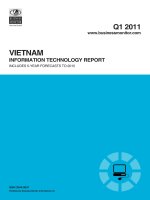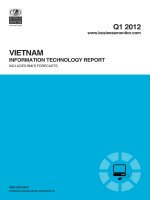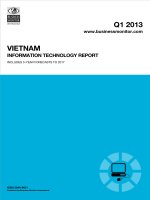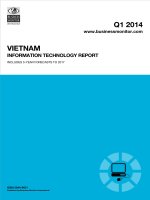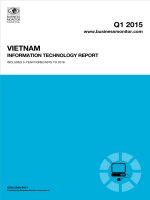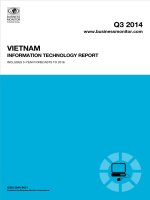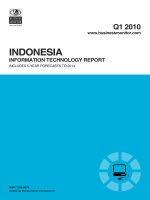Australia information technology report q1 2014
Bạn đang xem bản rút gọn của tài liệu. Xem và tải ngay bản đầy đủ của tài liệu tại đây (451.95 KB, 86 trang )
Q1 2014
www.businessmonitor.com
AUSTRALIA
INFORMATION TECHNOLOGY REPORT
INCLUDES 5-YEAR FORECASTS TO 2017
ISSN 2041-7160
Published by:Business Monitor International
Australia Information Technology
Report Q1 2014
INCLUDES 5-YEAR FORECASTS TO 2017
Part of BMI’s Industry Report & Forecasts Series
Published by: Business Monitor International
Copy deadline: December 2013
Business Monitor International
Senator House
85 Queen Victoria Street
London
EC4V 4AB
United Kingdom
Tel: +44 (0) 20 7248 0468
Fax: +44 (0) 20 7248 0467
Email:
Web:
© 2013 Business Monitor International
All rights reserved.
All information contained in this publication is
copyrighted in the name of Business Monitor
International, and as such no part of this
publication may be reproduced, repackaged,
redistributed, resold in whole or in any part, or used
in any form or by any means graphic, electronic or
mechanical, including photocopying, recording,
taping, or by information storage or retrieval, or by
any other means, without the express written consent
of the publisher.
DISCLAIMER
All information contained in this publication has been researched and compiled from sources believed to be accurate and reliable at the time of
publishing. However, in view of the natural scope for human and/or mechanical error, either at source or during production, Business Monitor
International accepts no liability whatsoever for any loss or damage resulting from errors, inaccuracies or omissions affecting any part of the
publication. All information is provided without warranty, and Business Monitor International makes no representation of warranty of any kind as
to the accuracy or completeness of any information hereto contained.
CONTENTS
BMI Industry View 7
Headline Expenditure Projections 7
Key Trends And Developments 7
IT SWOT 10
Wireline SWOT 12
Political 14
Economic 15
Business Environment 16
Industry Forecast 18
Table: Australia IT Sector - Historical Data And Forecasts (AUDmn) 18
Broadband 22
Table: Telecoms Sector - Broadband - Historical Data & Forecasts 22
Macroeconomic Forecasts 24
Ongoing Misallocation Of Capital Increases Risks 26
Increasing Pressures For Greater Macro-Prudential Rules 27
Table: Australia - Economic Activity 29
Industry Risk Reward Ratings 30
Table: Asia Pacific IT Risk/Reward Ratings - Q1 2014 33
Market Overview 34
Hardware 34
Software 40
Services 42
Industry Trends And Developments 49
Regulatory Development 52
Table: Government Authority 52
Government Initiatives 52
Regulatory News 54
Competitive Landscape 56
International Companies 56
Table: Dell 56
Table: Datacom 57
Table: SAP 58
Table: Panasonic 59
Local Company 60
Table: The Good Guys 60
Australia Information Technology Report Q1 2014
© Business Monitor International Page 4
Company Profile 61
SAP 61
Hewlett-Packard 66
Regional Overview 73
Hardware Sales Opportunity Remains 75
Demographic Forecast 77
Demographic Outlook 77
Table: Australia's Population By Age Group, 1990-2020 ('000) 78
Table: Australia's Population By Age Group, 1990-2020 (% of total) 79
Table: Australia's Key Population Ratios, 1990-2020 80
Table: Australia's Rural And Urban Population, 1990-2020 80
Methodology 81
Industry Forecast Methodology 81
Sources 82
Risk/Reward Rating Methodology 83
Table: It Risk Reward Rating Indicators 84
Table: Weighting Of Components 85
Australia Information Technology Report Q1 2014
© Business Monitor International Page 5
BMI Industry View
BMI View: Australian IT sales are expected to reach AUD26.413mn in 2013, up 4%, with the market
continuing to offer opportunities despite business concerns about a domestic economic slowdown and the
global economic situation. Tablet sales growth is compensating for the decline in desktop and notebook
shipments, while investments in broadband infrastructure are boosting Australia's digital economy, and
enabling wider adoption of services such as cloud computing, online banking and e-commerce. High-
income consumers make Australia a fertile ground for premium devices such as tablets and ultrabooks,
while government tenders will also be supportive of spending levels in areas such as education, e-
government, transport and healthcare.
Headline Expenditure Projections
Computer Hardware Sales: AUD11.1bn in 2012 to AUD11.3bn in 2013, up 2.2% in local currency terms.
Strong demand for tablets is compensating for a decline in desktops and notebook shipments. The release of
new devices using Intel's latest Haswell chipset architecture could boost shipments in H213.
Software Sales: AUD4.1bn in 2012 to AUD4.3bn in 2013, up 2.2% in local currency terms. Security
software sales are increasing, particularly for small and medium-sized enterprises (SMEs) and consumers.
Enterprise resource planning and other e-business products to the small and medium-sized enterprise market
will be a key trend driving sales
IT Services Sales: AUD10.2bn in 2012 to AUD10.8bn in 2013, up 5.8% in local currency terms. IT
services will be the outperforming growth area, with cloud services the key growth driver as local
companies try to use efficiencies enabled by the National Broadband Network (NBN).
Risk/Reward Ratings: Australia's score is 68.0 out of 100.0. Australia's score has declined due to a lower
growth outlook. The country ranks fourth in our latest Asia Risk/Reward Ratings table, behind Singapore,
South Korea and Hong Kong, but still ahead of larger markets in the region such as China, India and
Indonesia.
Key Trends And Developments
Cloud computing is expected to be one of the leading IT market trends globally, but in Australia there is
potential for particularly fast growth thanks to the investments in improving connectivity via the NBN. This
will extend the reach of services, as well as providing the faster upload speeds that are key to advanced
Australia Information Technology Report Q1 2014
© Business Monitor International Page 7
cloud computing services. Cloud computing has already gained traction in Australia, with the big four banks
deploying solutions and leading international vendors such as IBM, Oracle and Amazon Web Services
investing in the market. The NBN and the government's cloud computing strategy, announced in May 2013,
are expected to catalyse the cloud market's development in the relatively underpenetrated areas of the public
sector and with SMEs.
In June 2013 it was reported that the Australian Communications and Media Authority (ACMA) was
considering implementing regulatory measures to oversee the use of cloud technology. In a discussion
paper, security, privacy and access to data were all identified as issues that might need regulating.
Subsequently, the government outlined a policy for the adoption and use of cloud computing in official
administrative processes. Its guidelines emphasise the importance of striking a balance between taking
advantage of the cost, flexibility and scalability benefits of cloud computing, and of keeping large quantities
of private data secure. Of vital importance is that the most sensitive of government-held information is not
subject to any undue threats.
Over the past quarter, there have been a number of important developments in the cloud computing sphere.
Thus, in October, the Australia-based cloud services provider Bulletproof unveiled the country's first
Amazon Web Services (AWS) pay-as-you-go support solution, called On Demand. The service will
incorporate 24-hour customer support, including assistance in 15 minutes for critical issues. On Demand
will have no fixed or ongoing costs, and will employ an as-a-service model whereby customers will
instantly have access to Bulletproof's 24-7 support, but will only pay for the support time they use.
Meanwhile, major new cloud services continue to be set up: in August 2013, US virtualisation software
company VMware revealed that it was preparing to roll-out its hybrid cloud service in Australia, working
with a local partner to launch the vCloud Hybrid Service. Australia will be the first Asia-Pacific region to
receive the new VMware service due to its high rate of virtualisation and status as a mature market. Then, in
November 2013, South Africa-based ICT services provider Dimension Data announced that over the next
three months it would be setting up four new global cloud data centres, one of which would be in
Melbourne, Australia.
Australia has also been quick to embrace the growing bitcoin trend, with Australian-based start-up company
CoinJar announcing in December 2013 that it will receive "Australia's first major bitcoin investment", after
it signed a AUD455,000 deal with local venture capital firm Blackbird Ventures. Coinjar is a bitcoin
buying/selling exchange that was founded in February 2013.
Australia Information Technology Report Q1 2014
© Business Monitor International Page 8
The latest data on Australia's hardware market show that tablets have made significant progress, while
shipments of desktops and notebooks are in decline. BMI estimates tablet sales of 2.1mn in 2012, only just
behind notebook shipments, and we expect tablets to overtake notebook shipments in 2013 as a wider range
of form factors and price points deepen the market beyond premium/luxury devices. However, the trend of
tablet sales replacing notebook purchases is less clear cut. Microsoft's partner vendors have demonstrated
the potential for hybrids/convertibles, which combine productivity and content consumption use cases, in
H113, and the release of Intel's latest Haswell chipset architecture in June 2013, enabling slimmer and
longer battery life devices, is expected to accelerate this innovation and blur the distinctions between
devices.
Australia Information Technology Report Q1 2014
© Business Monitor International Page 9
IT SWOT
SWOT Analysis
Strengths
■
High incomes and strong supporting infrastructure support high spending.
■
Strong government support for ICT programmes.
■
IT-literate population with high levels of PC ownership.
■
Strong financial sector.
■
Tablet sales are compensating for decline in desktop and notebook sales.
Weaknesses
■
Australia has a relatively mature domestic market, with relatively slow growth rates.
■
Sensitive to volatility in the global economy.
Opportunities
■
Government cloud computing strategy creates opportunities for vendors in the public
and SME sectors.
■
Launch of Windows 8 increases growth potential for Microsoft partners in the tablet
and laptop hybrid market, particularly following the release of Haswell chips in June
2013.
■
Considerable demand for cloud computing services.
■
Phase two of the computers for schools project was expected to generate an
additional US$800mn of spending.
■
Other major IT projects in areas such as healthcare and smart cards.
Australia Information Technology Report Q1 2014
© Business Monitor International Page 10
SWOT Analysis - Continued
Threats
■
The biggest threat is of an economic slowdown in 2013, leading to a scaling back of
IT budgets.
■
A cheaper Australian dollar would affect consumer and business demand in the
import-dependent IT market.
■
Vendors face threat of parliamentary enquiry into product pricing and are coming
under pressure regarding tax arrangements.
Australia Information Technology Report Q1 2014
© Business Monitor International Page 11
Wireline SWOT
Wireline SWOT
Strengths
■
Australia's overall wireline sector is host to a large number of service providers, many
of which offer a full range of voice, data and internet services.
■
Many service providers offer broadband internet connectivity by means of several
different technologies.
■
The penetration rate, measured as a proportion of buildings reached with broadband
network infrastructure, is extremely high.
■
The residential market supports strong demand for pay-TV services.
■
The business market supports strong demand for converged data services.
■
Australia's leading broadband operators continue to report strong internet and
multimedia service sales.
Weaknesses
■
Despite a significant number of service providers, the broadband market continues to
be dominated by Telstra.
■
Despite fixed-line market liberalisation and steady growth in the number of unbundled
local loops, Telstra remains the dominant player in the sector.
■
After a period of moderate growth, business demand for fixed telephony lines now
appears to be weakening.
■
Overall, demand for traditional fixed-line services is shrinking, resulting in a
diminishing market.
Opportunities
■
The National Broadband Network (NBN), announced in April 2013, aims to be
completed sooner and cheaper, with the trade-off being slower connectivity.
■
Demand for wireless broadband services, including WiMAX, 3G datacard and USB
modem-supported services is growing.
Australia Information Technology Report Q1 2014
© Business Monitor International Page 12
Wireline SWOT - Continued
■
Australia's leading broadband operators are investing in the development of higher
speed broadband services. This has potential to drive demand for new data services.
■
The government revealed that it has set aside AUD60mn for regional, rural and
remote telecoms projects; satellite and wireless broadband networks are seen as a
source of potential investment in remote regions.
Threats
■
Fixed-line sector may decline at a more rapid rate than expected, with potentially
negative consequences for ADSL growth.
■
Proliferation of naked ADSL could hasten the decline of the fixed-line sector.
■
Growing popularity of wireless broadband services could negatively affect the market
for fixed broadband access based on DSL and cable.
■
The high rate of broadband penetration reduces the scope for further growth in the
broadband sector; growth will slow as the market nears saturation point.
■
Following the election of the new Liberal-National Coalition (LNC) government in
September 2013, the NBN is likely to offer slower connectivity than originally
envisaged.
Australia Information Technology Report Q1 2014
© Business Monitor International Page 13
Political
SWOT Analysis
Strengths
■
Australia is a mature democracy with a broadly stable party system.
■
Economic stability over recent years supports the current political system and radical
groups are unlikely to gain substantial support.
Weaknesses
■
As one of the region's largest and most stable states, the country attracts many
refugees and economic migrants. The issue is a key source of domestic tension and
has been hotly debated in parliament in recent times as the capsizing of a boat led to
the death of a number of refugees. The issue continues to be debated in the federal
parliament with no sign of political parties co-operating to find an alternative that
would ensure the safe passage and fair processing of the refugees, while reducing the
possibility of people smuggling.
■
The fragility of the state governments' finances compared to the large infrastructure
projects that they need to undertake has led to questions with regards to the
compatibility of the federal-state system with the country's current development
needs.
Opportunities
■
Australia has historically enjoyed close military ties with the US. However, with the
rise of regional economic powers such as China, it will need to balance competing
military and economic ties.
Threats
■
Australia's early support for the US 'War on Terror', among other things, has made
Australians abroad a target for Islamic extremists.
■
Australia's close alliance with the US, particularly under John Howard, has left a
lingering feeling among some Asian governments that it is America's 'deputy sheriff'
in the region.
Australia Information Technology Report Q1 2014
© Business Monitor International Page 14
Economic
SWOT Analysis
Strengths
■
A free-market economy supported by a highly educated workforce.
■
Blessed with rich natural resources, Australia's economic activity has been
augmented by demand for commodity exports and the investments made in the
mining sector.
Weaknesses
■
The persistent current account deficit increases vulnerability to capital flows and, by
extension, currency volatility.
■
The export basket is highly concentrated in commodities, and consequently exposes
the economy and currency to fluctuations in world prices for metals, coal and
agricultural goods.
Opportunities
■
The rapid expansion of Asian economies in recent years offers new opportunities for
diversifying trading ties from core European markets.
■
A low level of government debt has provided a certain amount of flexibility in fiscal
policy to support domestic demand through the downturn.
Threats
■
The high level of private sector debt - especially mortgage loans - fuelled by overseas
funding poses a threat to sustained growth.
■
A collapse in exports from a drop in resource demand from China and other resource-
hungry countries would severely impact headline GDP growth.
■
Australia is vulnerable to extreme weather that may lead to droughts and floods,
which have become increasingly severe in past years as a result of global climate
change.
Australia Information Technology Report Q1 2014
© Business Monitor International Page 15
Business Environment
SWOT Analysis
Strengths
■
A highly educated workforce and comparatively modern transport infrastructure
underpin economic prospects.
■
A number of free trade agreements with countries such as New Zealand, Thailand and
the US serve as a boon for trading activities.
Weaknesses
■
Despite its openness, Australia requires the Foreign Investment Review Board to
approve any commercial real estate investment by a foreign company or individual
valued at US$5mn or more.
■
With a population of just over 22mn, the domestic consumer base is small by regional
standards.
Opportunities
■
Australia is currently in talks with China, Malaysia, the Gulf Co-operation Council,
Indonesia, India, Japan and South Korea regarding potential bilateral free trade
agreements. It is also part of negotiations for the Trans-Pacific Partnership and a
regional south pacific pact, PACER plus.
■
Upgrade and expansion of urban infrastructure will be needed to sustain population
growth in Australia's main cities, providing opportunities for public-private
partnerships in the future. The government is also targeting infrastructure
improvements to rural areas.
■
More healthcare infrastructure will be needed to support the ageing population, and
with the introduction of the federal government's National Disability Insurance
Scheme, the industry is likely to see increasing demand for services.
Threats
■
Corporate taxes for foreign investors in Australia remain higher than in other
countries, and it seems unlikely that the government will succeed to reduce the rates
in the near future.
■
Recent investment proposals by Chinese firms regarding the agricultural and resource
extraction sector have raised fears that strategic assets will be lost to foreign players.
This has led to more conditions attached to the sale agreements, which is likely to
Australia Information Technology Report Q1 2014
© Business Monitor International Page 16
SWOT Analysis - Continued
reduce the attractiveness of these assets. It remains to be seen if the recent
implementation of a database to increase transparency around foreign-owned
Australian assets will spur more regulation.
Australia Information Technology Report Q1 2014
© Business Monitor International Page 17
Industry Forecast
Table: Australia IT Sector - Historical Data And Forecasts (AUDmn)
2010 2011 2012 2013e 2014f 2015f 2016f 2017f
IT market value 23,383 24,318 25,390 26,413 27,943 29,530 31,045 32,578
of which hardware 10,569 10,814 11,090 11,334 11,772 12,255 12,617 13,064
- PC 8,561 8,781 9,094 9,385 9,747 10,147 10,447 10,817
- Servers 951 973 998 1,020 1,060 1,103 1,135 1,176
of which software 3,835 4,068 4,118 4,303 4,435 4,695 5,048 5,200
of which services 8,979 9,435 10,181 10,777 11,736 12,580 13,380 14,315
IT market, % of GDP 1.7 1.7 1.7 1.7 1.7 1.7 1.7 1.7
e/f = estimate/forecast. Source: BMI
BMI has maintained its forecast of 4% growth for the Australian IT market in 2013. Although PC sales
have declined, strong tablet sales mean the overall performance of the hardware market is in line with our
expectations. We expect the IT market to reach AUD26,413mn in 2013, up from AUD25,390mn in 2012.
We expect growth to be on average faster than in 2013. We forecast a total IT market spending compound
annual growth rate (CAGR) of 5.1% in 2013-2017, with the market reaching AUD32,578mn in 2017. Over
this period the market will remain stable at around 1.7% of GDP.
The Australian IT market has considerable medium-term potential, particularly in areas such as tablets,
cloud computing and real-time enterprise software. However, in the short term, BMI forecasts a slowdown
in economic growth in 2013, which we expect to spill over to the IT market. Despite the wider economic
uncertainty, the IT market will continue to grow throughout our forecast period.
Australia Information Technology Report Q1 2014
© Business Monitor International Page 18
2013 Outlook
We expect growth in 2013 to be slower than 2012,
dropping 0.4 percentage points (pps) to 4%. The key
factor behind this slowdown is the more downbeat
economic outlook for Australia in 2013. We expect
real GDP growth will fall to just 2.1% in 2013 from
3.2% in 2012, with the real terms increase in private
final consumption falling to 1.2% from 3.0%. This
will dampen spending both in the retail and business
market. We expect unemployment will peak in 2014
at 6.2%, before falling for the rest of our forecast
period to 2017.
The slowdown in economic growth will be a drag on
the IT market in 2013. However, Australia remains a
very attractive market due to a range of factors, not
least of which is the high level of GDP per capita, at
a forecast US$69,483 in 2013. This gives Australian
consumers high levels of purchasing power to spend on consumer products such as tablets, laptop-hybrids
and ultrabooks. Data for Q113 show that, while demand for desktops and notebooks declined in Q113, sales
of tablets have continued to surge. Although consumers are facing a less accommodating environment, they
are still willing to spend on attractive mobile PCs. We believe the release of a new generation of desktops,
notebooks, convertibles/hybrids and tablets based on Intel's new Haswell chip architecture could boost
sales.
Government spending levels are increasing generally, and the government has a number of programmes
specifically boosting IT spending, eg the National Broadband Network (NBN), which is extending
connectivity across the country. We expect government spending to increase by 2% in real terms in 2013,
up from 1% in 2012. Government programmes should also help keep computer hardware sales in positive
growth territory. Government subsidies of computers in education will provide support for the market.
National and state governments will continue to roll out new initiatives, and the Victoria government has
invested more than US$150mn in IT in schools. New South Wales and Queensland were also rolling out IT
for schools projects.
IT Market Industry Trends
2010-2017
e/f = estimate/forecast. Source: BMI
Australia Information Technology Report Q1 2014
© Business Monitor International Page 19
Looking at the enterprise segment, with the exception of a few key areas, demand for IT products and
services will continue to be squeezed by weak business confidence due to an uncertain economic outlook. In
2011 business demand was hit by concerns about the economic situation in Europe and the US, as well as
domestic issues such as the proposed carbon tax. However, sectors such as government, telecoms,
healthcare and banking should continue to supply demand for implementation, consulting and managed
services. The potential for a Chinese hard-landing would likely have far-reaching consequences for
Australia, which could go beyond the impact of the crisis in developed markets.
Economic concerns aside, there are areas of growth in the enterprise segment, which are mainly based on
the increasing prevalence of connectivity. After the narrow victory of the Labor party-led coalition in the
2010 elections, the decision to continue the development of the NBN had a positive impact by boosting the
reach and quality of broadband infrastructure. Three key areas that stand to benefit are cloud computing,
data analytics and machine-to-machine communications.
In 2013, leading Australian private and public sector organisations are expected to continue their
deployment of cloud services. Surveys indicate that cloud computing is a priority for Australian CIOs, while
the release of the government's cloud computing strategy in Q213 should also boost deployments. Cloud
initiatives have already been implemented by many of the country's leading banks, and across sectors cloud
adoption is spreading from storage and email to areas such as human resources management. The
government has adopted a six-year cloud computing strategy. Cloud computing spending could reach
around AUD4bn by 2017.
Market Drivers
The squeeze on the IT market from a slowdown in economic growth in 2013 will alleviate over the medium
term. BMI forecasts the Australian economy will register an average of 2.4% real GDP growth 2013-2017,
with private final consumption increasing slightly slower annual average of 1.5% real growth. Australia is a
high-income market and we expect it to remain attractive for premium products, with low inflation and
unemployment, a contrast to many other high-income economies around the world that have higher risk
levels.
Government initiatives such as e-government, healthcare and education will drive significant opportunities
for IT vendors over the medium term. The National E-Health Transition Authority aims to create a
paperless environment in Australia's health sector, including public hospitals. Although the government is
pursuing investments in IT in a number of areas, it is reviewing procurement procedures to reduce cost,
which could squeeze vendor margins. For instance, in early 2013 the Australian Government Information
Australia Information Technology Report Q1 2014
© Business Monitor International Page 20
Management Office (AGIMO) consolidated its contracts with Microsoft through a single reseller to deliver
cost savings of AUD100mn.
Governmental broadband plans will provide a boost to the development of Australia's digital
economy. Increased reach of broadband infrastructure will boost activities such as online banking and
shopping, while the increased upload speeds delivered by the NBN will be a crucial enabler for widespread
adoption of cloud computing services.
Meanwhile, in the enterprise segment, regulatory compliance will result in continued spending by banks,
and intense competition in the retail sector is spurring spending on customer relationship management
(CRM) and back-office systems. Competition in the telecoms field is a driver for that key IT spending
segment, where deregulation has led to new entrants. High labour costs in Australia will generate demand
for services that replace labour, such as Ask Watson, adopted by ANZ Bank in H113. Such technology is in
the early stages of commercial deployments, but BMI believes that Australia could be a fertile market for
such technology over the medium term on the basis of potential cost savings.
Segments
BMI estimates that household PC penetration crossed the 90% threshold in H113, meaning there is little
scope for growth in first-time PC sales. This means the market will grow slower relative to emerging
markets in the region. However, there are large opportunities in the personal/upgrade device market as we
expect consumers will continue to be willing to spend on innovative devices that offer new use cases.
Tablets are the most prominent device meeting these requirements, but we believe hybrids/convertibles and
ultrabooks that use Haswell chips could gain traction in Australia.
The software market is expected to register faster growth than the hardware market, growing with a CAGR
of 4.8% from 2013 to 2017. Even so it will still remain at less than half the hardware market size by 2017.
Enterprise resource planning (ERP), customer relationship management (CRM) and business intelligence
solutions will be increasingly popular in the small and medium-sized enterprise (SME) market, as
companies aim to enhance productivity through the automation of essential functions. BMI believes
security software has potential for strong growth over the medium term as awareness about threats grows,
particularly among SMEs.
BMI expects IT services will be the outperforming segment of the IT market in the medium term, as
demand is driven by cloud computing services, data analytics and machine-to-machine communications.
Cloud computing should see strong growth with the rollout of the NBN and the release of the government's
Australia Information Technology Report Q1 2014
© Business Monitor International Page 21
cloud computing strategy in 2013. Opportunities will exist in telecoms, healthcare and utilities
verticals. Cloud computing will be key as businesses look for opportunities to reduce cost and increase
flexibility, and has already gained traction in the market and spread beyond initial core application areas,
with around one-third of Australian organisations estimated to be using some cloud services.
Over the medium term the development of supporting infrastructure, new cloud computing offerings and
increased competition in this segment are expected to fuel further demand from end-users for this
technology. The federal government has set out a timetable for migrating government agencies' computing
systems to a public cloud environment. Australia's big four banks will remain in the vanguard of moves
towards cloud computing after revaluating their IT spend during the economic downturn.
Summary
The hardware market is forecast to grow from AUD11,334mn in 2013 to AUD13,064mn in 2017, with PC
sales (including accessories) forecast to rise from AUD9,385mn to AUD10,817mn, boosted by computer
procurement for education and new form factors. Software spending is forecast to rise from AUD4,303mn
to AUD5,200mn and IT services from AUD10,777mn to AUD14,315mn.
Broadband
Table: Telecoms Sector - Broadband - Historical Data & Forecasts
2010 2011 2012 2013f 2014f 2015f 2016f 2017f
No. of internet users ('000) 16,922 17,859 18,752 19,690 20,675 21,502 22,362 23,256
No. of internet users/100 inhabitants 75.5 78.5 81.4 84.4 87.5 89.9 92.3 94.8
No. of broadband internet subscribers ('000) 9,739 11,123 12,161 12,647 13,090 13,483 13,887 14,304
No. of broadband internet subscribers/100
inhabitants 43.5 48.9 52.8 54.2 55.4 56.4 57.3 58.3
f = BMI forecast. Source: BMI, ITU, Australian Bureau of Statistics, operators
Australia Information Technology Report Q1 2014
© Business Monitor International Page 22
BMI has made slight adjustments to the forecasts
for broadband subscriptions as new data from the
Australian Bureau of statistics show there were
12.161mn broadband subscriptions in the market at
end-2012, rising to 12.358mn in June 2013. This
shows the market grew faster than expected in 2012,
but highlights a notable slowdown in growth in
H113, leading to BMI adjusting 2012 estimates for
the market.
Our internet user figures remain unchanged. We
believe the number of internet users will continue
trending upwards in light of the growing
affordability of internet subscriptions. The large-
scale deployment of Australia's National Broadband
Network (NBN) will ensure that the country's entire
population will have access to high-speed internet
connectivity. We forecast 23.3mn internet users by
end-2017, a penetration rate of 94.8%.
The majority of Australia's internet subscribers, 96.4%, were using some forms of broadband connections,
while a decreasing number of users were using dial-up services. Mobile broadband overtook DSL as the
main form of broadband connection in December 2010, and the gap between the two continues to widen.
We expect the Australian broadband market to continue exhibiting growth potential with the mobile
broadband segment forming the main growth driver. It is also increasingly common for customers to own a
fixed and mobile broadband connection. The NBN aims to deliver broadband services, either by fixed or
wireless means, to the entire population, and achieving this goal on target should provide a boost to the
broadband uptake towards the end of our forecast period.
The Australian broadband sector grew by 9.3% in 2012, and the growth rate should soon fall into the single-
digit range in light of market saturation. We expect this scenario played out in 2013 with the number of
broadband subscribers reaching 12.65mn, Thereafter, we forecast the number of broadband subscribers to
reach 14.3mn in 2017, a penetration rate of 58.3%.
Industry Trends - Broadband
2010-2017
Internet users, '000 (LHS)
Broadband subscribers, '000 (RHS)
2010
2011
2012
2013f
2014f
2015f
2016f
2017f
0
10,000
20,000
30,000
10,000
12,500
15,000
f = BMI forecast. Source: BMI, Australian Bureau of
Statistics, operators
Australia Information Technology Report Q1 2014
© Business Monitor International Page 23
Macroeconomic Forecasts
BMI View: Several domestic and external factors have served to boost the level of economic activity in
Australia. While we revised up our GDP growth forecasts for 2014 to 2.0% from 1.8% previously, this
change masks our concerns for the ever-growing risks within the Australian economy. Given that an
increasing proportion of capital is being invested in the housing sector despite the weak performance of
business spending, (a turnaround in which is required to generate wage growth), this misallocation of
capital increases the economy's vulnerability to external shocks, on top of the ongoing weakness in the
mining sector.
Since the September elections, the Australia economy has recorded an uptick in activity levels and business
sentiment from the lows recorded earlier in 2013, supported by both domestic and external factors.
Domestically, prospects of lower regulatory burden, ranging from taxes to various regulatory procedures,
have helped lift the outlook for certain industries, such as oil and gas. Moreover, September's readings of
the performance indices showed that deterioration in the services and construction sectors were moderating,
while activity in the manufacturing sector posted expansion in both September and October. The expansion
recorded in the new order sub-indices for the manufacturing and construction sectors further suggests that
this recent up-tick in activity could persist in the near term.
Australia Information Technology Report Q1 2014
© Business Monitor International Page 24
Signs Of Life
Australia - Performance Of Manufacturing, Services And Construction Sector Indices
Source: BMI; Australian Industry Group
Externally, efforts by the Chinese authorities to stimulate their economy and the decision of the US Federal
Reserve to postpone any reduction to its ongoing unconventional monetary stimulus have helped lift key
commodity prices and import volumes, such as iron ore, from their earlier lows in June. Together with
domestic factors, these trends suggest that economic growth could hold up until Q214, and as such, we have
raised our 2014 forecast, expecting real GDP growth to come in at 2.0% versus our previous estimates of
1.8%. This upgrade, however, masks our downbeat medium-term outlook for the economy as risks of a
sharp deflationary shock to the Australian economy continue to grow larger.
Australia Information Technology Report Q1 2014
© Business Monitor International Page 25
